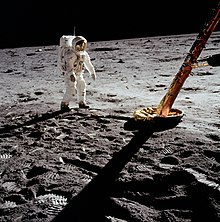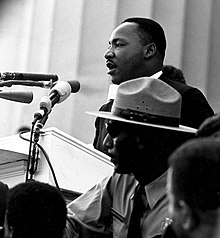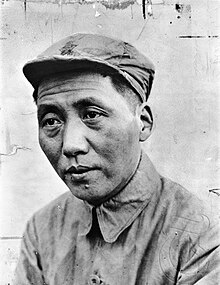1960s: Difference between revisions
m Reverted edits by 67.153.95.232 (talk) to last version by DakotaKahn |
Trickyager (talk | contribs) |
||
| Line 121: | Line 121: | ||
* Prime Minister [[Lester B. Pearson]] ([[Canada]]) |
* Prime Minister [[Lester B. Pearson]] ([[Canada]]) |
||
* Prime Minister [[Pierre Elliott Trudeau]] ([[Canada]]) |
* Prime Minister [[Pierre Elliott Trudeau]] ([[Canada]]) |
||
* Someone You Know [[Your Mom]] ([[Yourmamabad]]) |
|||
* Chairman [[Mao Zedong]] ([[People's Republic of China]]) |
* Chairman [[Mao Zedong]] ([[People's Republic of China]]) |
||
* President [[Chiang Kai-shek]] ([[Republic of China]] on Taiwan) |
* President [[Chiang Kai-shek]] ([[Republic of China]] on Taiwan) |
||
Revision as of 16:46, 17 May 2006
| Millennium |
|---|
| Centuries |
|
| Decades |
|
| Years |
|
|
| Categories |
The 1960s decade refers to the years from 1960 to 1969, inclusive. Informally, it can also include a few years at the end of the preceding decade or the beginning of the following decade.
The Sixties has also come to refer to the complex of inter-related cultural and political events which occurred in approximately that period, in Western countries, particularly Britain, France, the United States and West Germany. Social upheaval was not limited to just these nations, reaching large scale in nations such as Japan, Mexico and Canada as well. The term is used both nostalgically by those who participated in those events, and pejoratively by those who regard the time as a period whose harmful effects are still being felt today. The decade was also labeled the Swinging Sixties because of the libertine attitudes that emerged during the decade.
As with the Seventies, popular memory has conflated into the Sixties some events which did not actually occur during the period. For example, although some of the most dramatic events of the American civil rights movement occurred in the early 1960s, the movement had already began in earnest during the 1950s. On the other hand, the rise of feminism and gay rights began in the 1960s and continued into the next few decades. Homosexual acts between consenting adults in private were legalised in England and Wales in 1967. The "Sixties" has become synonymous with all the new, exciting, radical, subversive and/or dangerous (according to one's viewpoint) events and trends of the period, which continued to develop in the 1970s, 1980s and beyond.
Events and trends
The rise in social revolution, civil rights movements, human rights movement, anti-War movements, and the Counterculture movement are only some of the characteristics that defined the 1960s. Many experts attribute the 1960s "counter-culture revolution" as being the result of the major social and political factors that rose in the 1950s like brinksmanship, continued fighting in the 3rd world, and a return to pre-WWII lifestyle. The new generation was determined to reject a pre-WWII conformist lifestyle with men in suits and women in the kitchen. While many believed it to be just a "Western" phenomenon, the '60s revolution spread far beyond the borders of America and Western Europe. In South America, revolutions were at a height, in the Eastern Bloc, movements were made inspired by the Hungarian Revolution to reject Soviet domination, and in the Middle East attempted to resist Soviet and American domination (see Non-Aligned Movement). Overall, the '60s affected almost the entire globe. It was during this time that protectionist, command, and mixed economies reached their peak.
Technology


- USSR puts first man (Yuri Gagarin) and first woman (Valentina Tereshkova) in outer space
- The United States puts man on Earth's Moon Apollo 11
- Geosynchronous satellites revolutionize global communications
- Start of the development of algorithmic information theory
- The ARPAnet, precursor of the Internet, is founded in 1969 as a United States Department of Defense project. The numbered series of Request For Comments (RFC) documents begins in order to document the standards and practices of this network, and continues to this day
- Direct Use of the Sun's Energy by pioneer solar-energy scientist Farrington Daniels is published (1964)
- Compact audio cassette introduced; begins to displace reel-to-reel audio tape recording for home users
Science
- Discovery of plate tectonics revolutionizes understanding of continental drift
- Jacques Monod and Francois Jacob discover the lac operon
- Rise of the science of ecology in the awareness of the intelligentsia
War, peace and politics


- Cultural Revolution in mainland China causes political and economic chaos.
- Nigerian Civil War begins.
- 6-Day War between Israelis and Arabs in 1967.
- Beginning of The Troubles in Northern Ireland
- Berlin Wall built in 1961.
- Bay of Pigs Invasion in 1961, the United States sponsored a failed attempt to overthrow Cuba's socialist government and Fidel Castro.
- American Civil Rights Movement; end of official segregation and disenfranchisement of African-Americans; racial tensions continue with large race riots in Watts (Los Angeles) in 1966, and Detroit, Hough (Cleveland) and Newark in 1967.
- Sino-Indian War in late 1962. China attacks India and gains some land in Kashmir.
- Cuban Missile Crisis in 1962.
- Indo-Pakistani War of 1965 over Kashmir ends in a stalemate.
- The Vietnam War and protests, leading to Kent State University shootings in May, 1970.
- Suppression of uprising in Czechoslovakia.
- The Stonewall Riots in New York City give birth to the gay rights movement, June 1969.
- United Nations imposes sanctions against South Africa to protest the policy of Apartheid.
- Students protesting perceived problems with the status-quo are suppressed with violence by police and soldiers in USA, France, Mexico, and Czechoslovakia. See New Left.
- The Quiet Revolution (Révolution tranquille) begins in Quebec - precipitous decline of the Roman Catholic church, liberalism, social-democratic programs, and the birth of modern Quebec nationalism.
- The rise of radical feminism.
Economics
- Many countries in the Western world experience high economic growth (4 to 8% per year)
Culture
- Rock and roll develops, diversifies, and becomes very hip. The Beatles eclipse Elvis Presley and become the most popular musical artists in the world. "Topical" artists like Bob Dylan and Joan Baez worked social commentary into their music. Black Sabbath, arguably one of the most influential heavy metal bands of all time, is formed in 1968.
- 2001: A Space Odyssey hits movie theaters
- The long running BBC family science fiction show Doctor Who begins in 1963
- Star Trek makes its debut in 1966
- James Bond movies begin. Dr. No is the first of the series in 1962, starring Sean Connery as Bond
- Twiggy (Leslie Hornby) became internationally known as the world's first supermodel, voted the face of 66 by the Daily Express.
- Hippies, drug culture & rock and roll converge at the Woodstock festival, 1969
- In the West, the growing popularity of religions other than Christianity (for example, as discussed in the writings of Alan Watts), and of atheism; Time Magazine asks: "Is God Dead?" (See Fourth Great Awakening, Consciousness Revolution)
- Memorable expositions, or "World's Fairs," are held in Seattle (1962), New York City (1964/1965), Montreal (1967), and San Antonio (1968)
- Progressive rock emerges
- The fine arts begins to move away from exclusively consisting of painting, drawing, and sculpture and begins to incorporate elements from popular culture (Pop art) and begins to favor the ideas behind a work, rather than the work itself (Conceptual art)
Big changes during the Sixties
In the United States
The movement for civil and political rights for African Americans (in the early '60s usually called Negroes and in the later '60s Blacks), initially a non-violent movement led by Martin Luther King, Jr. and other Gandhian figures but later producing radical offshoots such as the Black Power movement and competing with the Black Panther Party and the Black Muslims for primacy in the African-American community.
The beginning of what was generally seen as a new political era with the election of President John F. Kennedy in 1960, and its ending in tragedy and disillusionment with Kennedy's assassination in 1963, the assassinations of King and Robert F. Kennedy in 1968, and the collapse of Lyndon Johnson's presidency.
The rise of a mass movement in opposition to the Vietnam War, ending in the massive Moratorium protests in 1969, and also the movement of resistance to conscription (“the Draft”) for the war. The antiwar movement was initially based on the older 1950s "Peace movement" controlled by the Communist Party USA, but by the mid '60s it outgrew this and became a broad-based mass movement centered on the universities and churches.
Stimulated by this movement, but growing beyond it, the large numbers of student-age youth, beginning with the Free Speech Movement at the University of California, Berkeley in 1964, peaking in the riots at the 1968 Democratic National Convention in Chicago, Illinois and reaching a climax with the shootings at Kent State University in 1970.
The rapid rise of a "New Left," employing the rhetoric of Marxism but having little organizational connection with older Marxist organizations such as the Communist Party, and even less connection with the supposed focus of Marxist politics, the organized labor movement, and consisting of ephemeral campus-based Trotskyist, Maoist and anarchist groups, some of which by the end of the 1960s had turned to terrorism.
The overlapping, but somewhat different, movement of youth cultural radicalism manifested by the hippies and the counter-culture, whose emblematic moments were the Summer of Love in San Francisco in 1967 and the Woodstock Festival in 1969.
The rapid spread, associated with this movement, of the recreational use of cannabis and other drugs, particularly new semi-synthetic psychedelic drugs such as LSD.
The breakdown among young people of conventional sexual morality and the flourishing of the sexual revolution. Initially geared mostly to heterosexual male gratification, it soon gave rise to contrary trends, Women's Liberation and Gay Liberation.
The rise of an alternative culture among affluent youth, creating a huge market for rock and blues music produced by drug-culture influenced bands such as The Beatles, Jefferson Airplane and The Doors, and also for radical music in the folk tradition pioneered by Bob Dylan.
In other Western countries
The peak of the student and New Left protests in 1968 coincided with political upheavals in a number of other countries. Although these events often sprang from completely different causes, they were influenced by reports and images of what was happening in the United States and France. Students in Mexico City, for example, protested against the corrupt regime of Gustavo Díaz Ordaz: in the resulting Tlatelolco massacre hundreds were killed.
The influence of American culture and politics in Western Europe, Japan and Australia was already so great by the early 1960s that most of the trends described above soon spawned counterparts in most Western countries. University students rioted in London, Paris, Berlin and Rome, huge crowds protested against the Vietnam War in Australia and New Zealand (both of which had committed troops to the war), and politicians such as Harold Wilson and Pierre Trudeau modeled themselves on John F. Kennedy.
An important difference between the United States and Western Europe, however, was the existence of a mass socialist and/or Communist movement in most European countries (particularly France and Italy), with which the student-based new left was able to forge a connection. The most spectacular manifestation of this was the May 1968 student revolt in Paris, which linked up with a general strike called by the Communist-controlled trade unions and for a few days seemed capable of overthrowing the government of Charles de Gaulle.
In non-Western countries
In Eastern Europe, students also drew inspiration from the protests in the West. In Poland and Yugoslavia they protested against restrictions on free speech by Communist regimes. In Czechoslovakia, 1968 was the year of Alexander Dubček’s Prague Spring, a source of inspiration to many Western leftists who admired Dubček's "socialism with a human face." The Warsaw Pact invasion of Czechoslovakia in August ended these hopes, and also fatally damaged the chances of the orthodox Communist Parties drawing many recruits from the student protest movement.
In the People's Republic of China the mid 1960s were also a time of massive upheaval, and the Red Guard rampages of Mao Zedong's Cultural Revolution had some superficial resemblances to the student protests in the West. The Maoist groups that briefly flourished in the West in this period saw in Chinese Communism a more revolutionary, less bureaucratic model of socialism. Most of them were rapidly disillusioned when Mao welcomed Richard Nixon to China in 1972. People in China, however, saw the Nixon visit as a victory in that they believed the United States would concede that Mao Zedong thought was superior to capitalism (this was the Party stance on the visit in late 1971 and early 1972). The Cuban revolutionary Ernesto "Che" Guevara also became an iconic figure for the student left.
People
World leaders

- Prime Minister Robert Menzies (Australia)
- Prime Minister Harold Holt (Australia)
- Prime Minister John McEwen (Australia)
- Prime Minister John Gorton (Australia)
- Prime Minister John Diefenbaker (Canada)
- Prime Minister Lester B. Pearson (Canada)
- Prime Minister Pierre Elliott Trudeau (Canada)
- Someone You Know Your Mom (Yourmamabad)
- Chairman Mao Zedong (People's Republic of China)
- President Chiang Kai-shek (Republic of China on Taiwan)
- President Gamal Abdel Nasser (Egypt)
- President Urho Kekkonen (Finland)
- President Charles de Gaulle (France)
- Prime Minister Jawaharlal Nehru (India)
- Prime Minister Lal Bahadur Shastri (India)
- Prime Minister Indira Gandhi (India)
- Prime Minister David Ben-Gurion (Israel)
- Prime Minister Levi Eshkol (Israel)
- Emperor Hirohito (Japan)
- Pope John XXIII
- Pope Paul VI
- Prime Minister Basil Brooke (Northern Ireland)
- Prime Minister Terence O'Neill (Northern Ireland)
- Prime Minister James Chichester-Clark (Northern Ireland)
- Governor Luis A. Ferré (Commonwealth of Puerto Rico)
- Taoiseach Sean Lemass (Republic of Ireland)
- Taoiseach Jack Lynch (Republic of Ireland)
- Nikita Khrushchev (Soviet Union)
- Leonid Brezhnev (Soviet Union)
- Prime Minister Suleyman Demirel (Turkey)
- Queen Elizabeth II (United Kingdom)
- Prime Minister Harold Macmillan (United Kingdom)
- Prime Minister Harold Wilson (United Kingdom)
- President Dwight D. Eisenhower (United States)
- President John F. Kennedy (United States)
- President Lyndon Johnson (United States)
- President Richard Nixon (United States)
- Chancellor Konrad Adenauer (West Germany)
- Chancellor Ludwig Erhard (West Germany)
- Chancellor Kurt Georg Kiesinger (West Germany)
- President for Life Josip Broz Tito (Yugoslavia)
Writers and intellectuals
- Isaac Asimov
- J. G. Ballard
- Basil Bunting
- Amiri Baraka
- William S. Burroughs
- Truman Capote
- Andy Capp
- Rachel Carson
- Noam Chomsky
- Judith Christ
- R. Crumb
- Philip K. Dick
- Irving Fiske
- Louise Fitzhugh
- Milton Friedman
- Allen Ginsberg
- Seamus Heaney
- Robert A. Heinlein
- Frank Herbert
- Jane Jacobs
- Ken Kesey
- Philip Larkin
- Timothy Leary
- Norman Mailer
- Marshall McLuhan
- Jules Pfeiffer
- Bertrand Russell
- Carl Sagan
- Jean-Paul Sartre
- Charles Schulz
- Dr. Seuss
- John Steinbeck
- Hunter S. Thompson
- Joseph Heller
- Gore Vidal
- Kurt Vonnegut
- Alan Watts
- Brian Wilson
- Tom Wolfe
External links
- The 1960s Week-By-Week - comprehensive 1960s coverage. Includes news, trends, pop culture
- The 1960s: A Bibliography
- h2g2 article on the 1960s
- A selection of texts from and about the radical and counterculture aspects of the '60s
- Pop Culture Madness 1960s Music Lists
- American Cultural History 1960 - 1969
